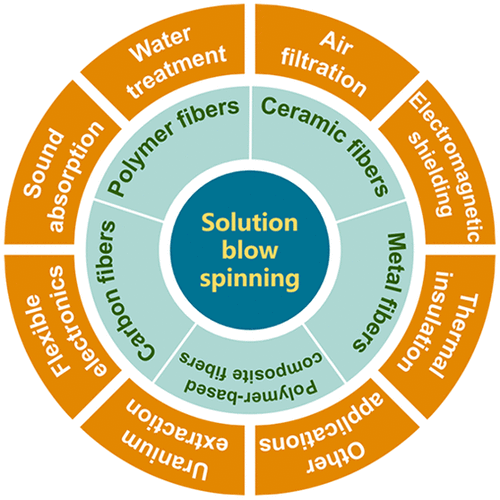当前位置:
X-MOL 学术
›
Acc. Mater. Res.
›
论文详情
Our official English website, www.x-mol.net, welcomes your
feedback! (Note: you will need to create a separate account there.)
Mass Production of Ultrafine Fibers by a Versatile Solution Blow Spinning Method
Accounts of Materials Research ( IF 14.0 ) Pub Date : 2021-06-04 , DOI: 10.1021/accountsmr.1c00040 Chao Jia 1, 2 , Lei Li 1 , Jianan Song 1 , Ziwei Li 1 , Hui Wu 1
Accounts of Materials Research ( IF 14.0 ) Pub Date : 2021-06-04 , DOI: 10.1021/accountsmr.1c00040 Chao Jia 1, 2 , Lei Li 1 , Jianan Song 1 , Ziwei Li 1 , Hui Wu 1
Affiliation

|
Ultrafine fiber materials have shown great application prospects in many fields due to their superior properties, including large specific surface area, high porosity, low density, and good mechanical flexibility. Various spinning methods have been developed to prepare ultrafine fiber materials, including electrospinning, solution blow spinning (SBS), centrifugal spinning, melt-blowing, etc. Among them, SBS combines the merits of electrospinning and melt-blowing. Unlike electrospinning, SBS uses a high-speed airflow as the driving force to stretch the spinning solution, and solvent evaporates rapidly in the process of liquid flow movement, thus obtaining ultrafine fibers. Compared with other spinning methods, SBS has many advantages, including simple and safe process, high efficiency, suitability for a wider range of solution systems, controllability of fiber structure and diameter, etc. Since its development in 2009, SBS has received widespread attention and has become an efficient and versatile tool for fabricating various ultrafine fiber materials with controlled microstructures and morphologies. Solution blow spun fibers can be assembled into a variety of configurations, including sponges, mats, papers, and films. The thickness of the fiber materials also can be easily regulated, which is an important advantage of SBS over electrospinning. The various forms of the blow spun fibers enable them to have a wide range of applications in environmental remediation, flexible electronic devices, energy storage and conversion, and biomedicine, among others.
中文翻译:

通过通用溶液吹塑法大规模生产超细纤维
超细纤维材料由于具有比表面积大、孔隙率高、密度低、机械柔韧性好等优越性能,在许多领域显示出巨大的应用前景。已经开发了多种纺丝方法来制备超细纤维材料,包括静电纺丝、溶液吹塑(SBS)、离心纺丝、熔喷等。其中,SBS结合了静电纺丝和熔喷的优点。与静电纺不同,SBS以高速气流为驱动力拉伸纺丝溶液,溶剂在液体流动运动过程中迅速蒸发,从而获得超细纤维。与其他纺丝方法相比,SBS 具有许多优点,包括工艺简单安全、效率高、适用于更广泛的溶液系统、纤维结构和直径的可控性等。自2009年发展以来,SBS受到了广泛的关注,已成为制造各种微结构和形貌可控的超细纤维材料的高效通用工具。溶液吹纺纤维可以组装成各种结构,包括海绵、垫子、纸和薄膜。纤维材料的厚度也很容易调节,这是 SBS 相对于静电纺丝的重要优势。各种形式的吹纺纤维使其在环境修复、柔性电子设备、能量存储和转换以及生物医学等领域具有广泛的应用。SBS 已受到广泛关注,并已成为制造具有可控微观结构和形态的各种超细纤维材料的有效且通用的工具。溶液吹纺纤维可以组装成各种结构,包括海绵、垫子、纸和薄膜。纤维材料的厚度也很容易调节,这是 SBS 相对于静电纺丝的重要优势。各种形式的吹纺纤维使其在环境修复、柔性电子设备、能量存储和转换以及生物医学等领域具有广泛的应用。SBS 已受到广泛关注,并已成为制造具有可控微观结构和形态的各种超细纤维材料的有效且通用的工具。溶液吹纺纤维可以组装成各种结构,包括海绵、垫子、纸和薄膜。纤维材料的厚度也很容易调节,这是 SBS 相对于静电纺丝的重要优势。各种形式的吹纺纤维使其在环境修复、柔性电子设备、能量存储和转换以及生物医学等领域具有广泛的应用。包括海绵、垫子、纸和薄膜。纤维材料的厚度也很容易调节,这是 SBS 相对于静电纺丝的重要优势。各种形式的吹纺纤维使其在环境修复、柔性电子设备、能量存储和转换以及生物医学等领域具有广泛的应用。包括海绵、垫子、纸和薄膜。纤维材料的厚度也很容易调节,这是 SBS 相对于静电纺丝的重要优势。各种形式的吹纺纤维使其在环境修复、柔性电子设备、能量存储和转换以及生物医学等领域具有广泛的应用。
更新日期:2021-06-25
中文翻译:

通过通用溶液吹塑法大规模生产超细纤维
超细纤维材料由于具有比表面积大、孔隙率高、密度低、机械柔韧性好等优越性能,在许多领域显示出巨大的应用前景。已经开发了多种纺丝方法来制备超细纤维材料,包括静电纺丝、溶液吹塑(SBS)、离心纺丝、熔喷等。其中,SBS结合了静电纺丝和熔喷的优点。与静电纺不同,SBS以高速气流为驱动力拉伸纺丝溶液,溶剂在液体流动运动过程中迅速蒸发,从而获得超细纤维。与其他纺丝方法相比,SBS 具有许多优点,包括工艺简单安全、效率高、适用于更广泛的溶液系统、纤维结构和直径的可控性等。自2009年发展以来,SBS受到了广泛的关注,已成为制造各种微结构和形貌可控的超细纤维材料的高效通用工具。溶液吹纺纤维可以组装成各种结构,包括海绵、垫子、纸和薄膜。纤维材料的厚度也很容易调节,这是 SBS 相对于静电纺丝的重要优势。各种形式的吹纺纤维使其在环境修复、柔性电子设备、能量存储和转换以及生物医学等领域具有广泛的应用。SBS 已受到广泛关注,并已成为制造具有可控微观结构和形态的各种超细纤维材料的有效且通用的工具。溶液吹纺纤维可以组装成各种结构,包括海绵、垫子、纸和薄膜。纤维材料的厚度也很容易调节,这是 SBS 相对于静电纺丝的重要优势。各种形式的吹纺纤维使其在环境修复、柔性电子设备、能量存储和转换以及生物医学等领域具有广泛的应用。SBS 已受到广泛关注,并已成为制造具有可控微观结构和形态的各种超细纤维材料的有效且通用的工具。溶液吹纺纤维可以组装成各种结构,包括海绵、垫子、纸和薄膜。纤维材料的厚度也很容易调节,这是 SBS 相对于静电纺丝的重要优势。各种形式的吹纺纤维使其在环境修复、柔性电子设备、能量存储和转换以及生物医学等领域具有广泛的应用。包括海绵、垫子、纸和薄膜。纤维材料的厚度也很容易调节,这是 SBS 相对于静电纺丝的重要优势。各种形式的吹纺纤维使其在环境修复、柔性电子设备、能量存储和转换以及生物医学等领域具有广泛的应用。包括海绵、垫子、纸和薄膜。纤维材料的厚度也很容易调节,这是 SBS 相对于静电纺丝的重要优势。各种形式的吹纺纤维使其在环境修复、柔性电子设备、能量存储和转换以及生物医学等领域具有广泛的应用。











































 京公网安备 11010802027423号
京公网安备 11010802027423号